소화불량과 소화성 궤양 Indigestion(Dyspepsia/Functional dyspepsia) and Peptic ulcer diseases
소화불량의 개요
- 영어로 소화불량을 Upset stomach 라고 한다.
- 소화불량(Indigestion)을 기능적 소화불량(Functional dyspepsia)이라고 한다.
- 어떤 기질적 병변이 위장관 등 소화기에 없지만 음식물을 너무 빨리 먹거나, 너무 많이 먹거나, 먹은 음식물이 체질에 맞지 않아 생긴 음식물 내성으로 오목가슴이 쓰리고 조금 불편하고 배가 조금 아픈 증상 징후가 생길 수 있다. 이렇게 생긴 병을 기능적 소화 불량 또는 소화 불량이라고 한다.
- 위식도 역류병, 위궤양 등 병이 있을 때 가슴이 쓰리고 아플 수 있고 소화 불량증이 생긴다. 또 임신으로 소화불량이 생길 수 있다.
- 소화불량으로 배가 갑자기 아플 수 있다.
- 일반적으로 소화불량으로 배가 아플 때는 참을 수 있을 정도로 배가 경도로 아픈 것이 보통이다.
- 소화불량으로 배가 아플 때는 열이 나지 않고 배가 아주 심하게 아프지 않는다.
- 오목가슴이 조금 불편스럽고 트림 할 수 있고 배부른 감이 있고 신트림을 할 수 있다.
- 이런 증상 징후가 하루 종일 있는 것이 아니라 대개 소화가 안 될 때만 일시적으로 생기면서 오랫동안 계속되지 않는다.
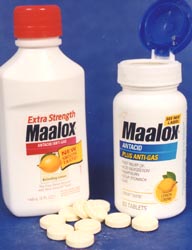
사진 1-176. 마알록스는 일종의 제산제이고 제가스제이다.
소화불량으로 배가 쓰릴 때 경구로 섭취하면 잘 치료된다.
미국에서는, 이것 말고 텀도 소화 불량치료에 의사의 처방 없이 약국이나 편의점에서 사서 치료할 수 있다. Copyrightⓒ 2011 John Sangwon Lee,MD., FAAP
소화 불량의 진단 치료
- 자세한 과거 병력, 현재 병력, 증상 징후, 검진결과를 종합 해 진단한다.
- 위식도 역류병, 음식물 불내증, 유당 불내증, 우유 단백 알레르기, 위궤양이나 십이지장 궤양, 약물 부작용, 담석증, 요석증, 변비, 흥분성 위장증후군, 정신 정서 심리문제, 종양, 복벽와 피부의 문제, 근육 문제, 헬리코박터 파이로리(Helicobacter pylori)균 감염병 등과 감별 진단을 하기 위해 적절한 검사를 한다.
- 소화불량으로 갑자기 배가 아플 때 메일록스 (Maalox), 마이란타(Mylanta), 리오판 (Riopan,) 또는 텀스(Tums) 등 제산 제가스제로 치료하든지 펩시드-AC(Famotidine)제로 의사의 처방 없이 치료 할 수 있다. [부모도 반의사가 되어야 한다-소아가정간호백과]-제21권 소아청소년 가정 학교 간호-가정에서 보관할 수 있는 약물 참조.
- 그 외 위장경련 진정제로 치료하면 소화불량으로 생기는 복통은 쉽게 가라앉는 것이 보통이다. 기능적 소화불량이 있다고 의심되면 대증 치료를 한다.
- 식사를 잘 조절해서 먹는 것도 좋은 치료 방법이다. 복통 참조 .
소화성 궤양 Peptic ulcer diseases
소화성 궤양의 개요
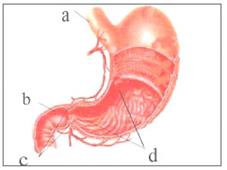
그림 1-30. 위 해부도
a-식도, b-유문, c-유문 괄약근, d-위 벽
출처; Used with permission from Glaxo Wellcome
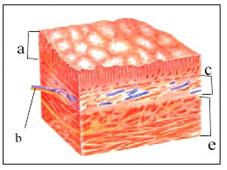
그림 1-31. 위 벽의 조직
a-점막층, b-혈관, c-점막층하 조직층, d-근육층, e-장막층
출처; Used with permission from Glaxo Wellcome
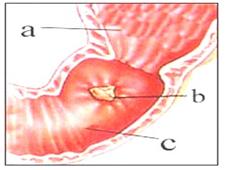
그림 1-32. 십이지장 궤양(소화성 십이지장 궤양)
a-위벽, b-소화성 십이지장 궤양, c-십이지장의 장벽
출처; Used with permission from Glaxo Wellcome과 소아가정간호백과
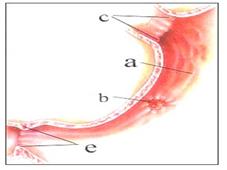
그림 1-32. 소화성 위궤양
a-위벽, b-소화성 위궤양, c-분문, e-유문
출처; Used with permission from Glaxo Wellcome과 소아가정간호백과

그림 1-33. 위 식도 역류
a-위 식도 경계, b-식도 벽, c-위액의 역류, d-위벽, e-분문, f-위액
출처; Used with permission from Glaxo Wellcome과 소아가정간호백과

그림 1-34. 식도 소화성 궤양
a-궤양, b-식도 벽, c-분문, d-위 벽
출처; Used with permission from Glaxo Wellcome과 소아가정간호백과
- 위, 십이지장, 또는 식도 하단 점막층이 위산과 펩신 등 위액에 노출될 때 위나 십이지장 등의 점막층이 둥글게 헐고 짓무르며 마치 화산 분화구 모양처럼 위, 십이지장, 또는 식도의 벽이 손상되는 위장관 병을 소화성 궤양이라고 한다.
- 소화성 궤양이 위 벽에 생기면 소화성 위궤양, 십이지장에 생기면 소화성 십이지장 궤양이라고 하고 식도 벽에 생기면 소화성 식도 궤양이라고 한다.
소화성 궤양의 원인
- 여기서는 편의상 소화성 위궤양을 위궤양, 소화성 십이지장 궤양을 십이지장 궤양이라고 칭한다.
- 위궤양이나 십이지장 궤양의 원인은 아직도 확실히 모른다.
- 친 부모 형제자매들 중 누군가가 위궤양을 앓았던 병력이 있으면 그들의 다른 형제자매들 중 누군가가 위궤양에 걸릴 가능성이 더 많다.
- O형 혈액형을 가진 소아청소년들, 스트레스를 많이 받는 아이들은 위궤양에 더 잘 걸릴 수 있다고 한다.
- 단백질 소화에 관련되는 효소 펩신과 위산, 그 밖에 다른 종류의 위액의 성분으로 위 점막층이나 십이지장 벽 점막층 또는 식도 벽 점막층 등이 국소적으로 손상될 때 위궤양이나 십이지장 궤양 또는 식도 궤양이 생길 수 있다.
- 따라서 펩신과 위산 등 위액에 접촉될 수 있는 위, 십이지장, 식도 하단부 등 위장관에 소화성 궤양이 생길 수 있다.
- 소장관 벽 조직층의 일부에 이소성 위 벽 점막층이 엉뚱하게 조금 끼어 있을 수 있다. 이소성 위 점막층이 있는 소장관의 일부에도 소화성 궤양이 생길 수 있다.
- 소화성 위궤양이나 소화성 십이지장 궤양이 생긴 위 점막층이나 십이지장 점막층은 붓고 헐고 짓무른다. 궤양이 점점 더 악화되면 궤양이 생겨 있는 전 점막층뿐만 아니라 그 궤양이 있는 점막층의 바로 밑에 있는 점막층 하 조직, 그 아래층에 있는 근육층까지 손상될 수 있다.
- 궤양이 점막층과 근육층까지 손상되면서 점점 더 퍼져갈 때 마지막으로 궤양이 생긴 위벽이나 십이지장의 장벽에 있는 혈관도 파열될 수 있다.
- 이럴 때 위궤양이나 십이지장 궤양이 있는 장벽에서 피가 날 수 있다.
- 거기서 피가 대량으로 날 때에는 피를 토하거나 빨간 피가 항문으로 나올 수 있다. 더 나아가서 위 벽이나 십이지장 벽 전체 층이 천공될 수 있다.
- 헬리코박터 파일로리균 감염으로 소화성 위궤양이 생길 수 있다. 위궤양이나 십이지장 궤양으로 갑자기 배가 아플 때 참조.
소화성 궤양의 증상 징후
- 소화성 위궤양이나 소화성 십이지장 궤양의 증상 징후는 나이, 중증도, 위궤양이나 십이지장 궤양의 합병증의 유무 등에 따라 다르다.
- 전형적인 증상 징후는 다음과 같다.
- 나이가 어릴수록 위궤양이나 십이지장 궤양의 증상 징후가 뚜렷하게 나타나지 않는 것이 보통이다.
- 학령기 아이들이나 사춘기 아이들에게 위궤양이나 십이지장 궤양이 생기면, 식사하기 바로 전과 식사 후 2∼3시간 경에 오목가슴이나 배꼽 부위나 배 전체가 쓰리고 아플 수 있다.
- 음식물을 먹는 시간과 관계없이 배가 아플 수 있다.
- 위나 십이지장에 소화성 궤양이 있지만 아무 증상 징후가 없을 수 있다.
- 드물게는 구토하기도 한다.
- 때로는 위 벽이나 십이지장 벽에 있는 궤양 환부에서 피가 대량으로 나 그 피를 토하거나 피똥을 누기도 한다.
- 궤양이 있는 위장 관 벽이 뚫려 위나 십이지장의 벽에 천공이 생기고, 출혈하고, 쇼크에 빠질 수 있다.
- 어떤 때에는 앞서 설명한 여러 가지 증상들 중 한두 가지 증상만 있어서 병원에 갔다가 소화성 위궤양을 우연히 처음 진단 받을 때도 있다.
- 드물게 위나 십이지장의 소화성 궤양으로 인해서 위나 십이지장관이 막힐 수 있다.
- 유아들이나 학령기 아이들, 사춘기 아이들의 위궤양이나 십이지장 궤양의 증상 징후는 성인들의 소화성 위궤양이나 소화성 십이지장 궤양의 증상 징후가 거의 비슷하다.
- 오목가슴이나 배꼽 주위, 아랫배, 또는 복부 전체가 아무 때나 불규칙하게 아플 수 있다.
- 어떤 때에는 며칠 동안, 또는 몇 주일 동안 조금도 아프지 않다가 아픈 증상이 재발될 수 있다.
- 합병증이 없으면 대부분 3∼8주 동안 적절히 치료해 주면 잘 낫는다.
- 그러나 재발될 수 있다.
소화성 궤양의 진단
- 병력·증상 징후·진찰소견 등을 종합하여 소화성 궤양이 있다고 의심되면 경구로 조영물을 먹은 후 식도·위·십이지장 X-선 사진검사 등으로 진단할 수 있으나 위장 X-선 사진 검사로는 확실히 진단할 수 없는 때도 있다.
- 이런 경우에는 혈액·소변·대변 검사를 한다. 특히 대변에 잠복혈이 나오나 검사해 본다.
- 특수 거울이 달린 위내시경을 위 속과 십이지장관 속에 넣고 내시경을 통해 위와 십이지장관의 점막층을 육안으로 직접 보고 진단한다.
- 식도염·위염·췌장염 및 담관에 생긴 여러 종류의 병, 위장관 기생충증, 충수염, 중금속 중독, 그 밖에 다른 병이 있을 때도 위나 십이지장 궤양의 증상 징후와 거의 비슷한 증상이 생길 수 있다. 그런 병들과 감별·진단해야 한다.
소화성 궤양의 치료
- 아직도 위궤양이나 십이지장 궤양을 100% 완치할 수 있는 치료 방법이 없다.
- 일반적으로 내과적으로 치료한다.
- 위산 농도를 감소시키기 위해서 알루미늄 하이드로옥사이드제나 마그네슘 트리실리케이트제, 또는 칼슘 카보네이드제 중 한두 가지의 제산제나 종합 제산제로 우선 치료한다.
- 액체 제산제가 정제 제산제보다 효과가 더 좋다고 한다.
- 제산제의 용량은 나이와 궤양의 중증도에 따라 다르다.
- 제산제를 복용하는 시간도 제산제 종류와 증상에 따라 다르다.
- 매 식사 후 1∼2시간 되었을 때와 잠자기 바로 전에 1회, 하루에 4회 복용하는 것이 보통이다.
- 프로반딘 부교감신경 작용 차단제를 1일 1회 자기 전에 복용할 수 있다.
- 의사의 처방에 따라 시메티딘(Cimetidine) 또는 가스터(Gaster)제 중 한 가지 약물을 선택해서 3∼8주일 동안 치료해 주면 소화성 궤양의 70∼80% 정도는 쉽게 낫는다.
- 시메티딘을 매 식사 30분 전과 자기 바로 전에 한 번 하루 두 번 복용한다.
- 균형 잡힌 영양가 있는 음식물을 섭취해야 한다.
- 커피·콜라·술 등 자극성 음식물은 소화성 궤양에 좋지 않은 음료수이다.
- 위궤양이나 십이지장 궤양으로 위장 출혈이 생기거나 위장 천공 등의 합병증이 있을 때에는 수술 치료를 한다.
- 헬리코박터 파일로리균 감염으로 소화성 궤양이 생길 수 있다.
- 이 균을 죽이기 위해선 아목시실린(Amoxacillin)과 메트로니다졸(Metronidazole/Flagyl)과 비스무스 서브샐리실에트(Bismuth subsalicylate) 이 세 가지 약(3종 치료약)으로 치료한다.
Indigestion (Dyspepsia/Functional dyspepsia) and Peptic ulcer diseases 소화불량과 소화성 궤양
Overview of indigestion (Dyspepsia/Functional dyspepsia) and Peptic ulcer diseases
- In English is called upset stomach. Indigestion is called functional dyspepsia.
- There are no organic lesions in the digestive tract, such as the gastrointestinal tract, but due to food resistance caused by eating too quickly, eating too much, or eating food not suitable for the constitution, symptoms of a concave chest, a little uncomfortable, and a little pain in the stomach may occur.
- This disease is called functional indigestion or indigestion. When there are diseases such as gastroesophageal reflux disease or gastric ulcer, chest soreness and pain may occur, and indigestion occurs. In addition, indigestion may occur due to pregnancy. Indigestion can cause your stomach to hurt suddenly.
- In general, when the stomach hurts due to indigestion, it is common that the stomach hurts mildly enough to be tolerated.
- When the stomach hurts due to indigestion, there is no fever and the stomach doesn’t hurt very badly.
- The anterior chest is a little uncomfortable, and you can burp, have a feeling of fullness, and you can have regurgitation of an acid stomach fluid.
- Signs, symptoms of these are not present throughout the day, but usually occur only temporarily with indigestion

Photo 1-176. Maralox is a kind of antacid and antigas.
If you take it orally when you have stomach aches due to indigestion,
it is well cured most time.
In the United States, Term can also be bought and treated at a pharmacy or convenience store for indigestion treatment without a doctor’s prescription.
Copyrightⓒ 2011 John Sangwon Lee, MD., FAAP
Diagnostic treatment of indigestion
- Detailed past medical history, current medical history, symptoms, signs, and examination results are synthesized and diagnosed.
- Gastroesophageal reflux disease, food intolerance, lactose intolerance, milk protein allergy, gastric ulcer or duodenal ulcer, drug side effects, cholelithiasis, urolithiasis, constipation, excitatory gastrointestinal syndrome, psycho-emotional psychological problems, tumors, abdominal wall and skin problems, muscle problems, Helicobacter infections.
- Appropriate tests are performed to make a differential diagnosis with infectious diseases such as Helicobacter pylori.
- When a stomach ache suddenly occurs due to indigestion, treatment with antacids such as Maalox, Mylanta, Riopan, or Tums, or treatment with Pepcid-AC (Famotidine) without a doctor’s prescription can do.
- [Parents should also be at least the half-doctors-Child and Family Nursing Encyclopedia]-Volume 21 Child and Adolescent Home School Nursing-See Drugs That Can Be Stored at Home.
- When treated with other gastrointestinal sedatives, abdominal pain caused by indigestion usually subsides easily. If you suspect that you have functional indigestion, symptomatic treatment is given. Eating well-controlled meals is a good treatment. See stomach pain. Peptic ulcer diseases
Overview of peptic ulcer disease

Figure 1-30. Stomach anatomy. a-esophagus, b-pylorus, c-pyloric sphincter, d-gastric wall. source; Used with permission from Glaxo Wellcome

Figure 1-31. Tissue of the stomach wall. a-mucosal layer, b-vascular, c-submucosal tissue layer, d-muscular layer, e-serous layer. source; Used with permission from Glaxo Wellcome

Figure 1-32. Duodenal ulcer (peptic duodenal ulcer). a-gastric wall, b-peptic duodenal ulcer, c-barrier of the duodenum source; Used with permission from Glaxo Wellcome Department of Pediatric Home Nursing

Figure 1-32. Peptic gastric ulcer. a-gastric wall, b-peptic gastric ulcer, c-cardinal sphinter, e-pylorus. Source; Used with permission from Glaxo Wellcome Department of Pediatric Home Nursing

Figure 1-33. Gastroesophageal reflux a-gastric esophageal border, b-esophageal wall, c-regurgitation of gastric juice, d-gastric wall, e-cardiac sphincter, f-gastric juice source; Used with permission from Glaxo Wellcome Department of Pediatric Home Nursing

Figure 1-34. Esophageal peptic ulcer a-ulcer, b-esophageal wall, c-cardiac, d-gastric wall source; Used with permission from Glaxo Wellcome Department of Pediatric Home Nursing
- When the mucous membrane of the stomach, duodenum or lower esophagus is exposed to gastric juices such as gastric acid and pepsin, the mucous membranes of the stomach or duodenum are rounded and crushed, and gastrointestinal diseases in which the walls of the stomach, duodenum, or esophagus are damaged like a volcanic crater are called peptic ulcer.
- If a peptic ulcer occurs on the wall of the stomach, it is called a peptic gastric ulcer, and if it occurs on the duodenum, it is called a peptic duodenal ulcer, and if it occurs on the esophagus wall, it is called a peptic esophageal ulcer.
Causes of peptic ulcer
- Here, for convenience, peptic gastric ulcer is referred to as gastric ulcer, and peptic duodenal ulcer is referred to as duodenal ulcer.
- The cause of gastric or duodenal ulcers is still unknown.
- If any of their parental siblings have a history of gastric ulcers, some of their other siblings are more likely to develop gastric ulcers. It is said that children and adolescents with blood type O and children who are under stress are more prone to stomach ulcers.
- Gastric ulcer, duodenal ulcer, or esophageal ulcer can occur when the gastric mucosa, duodenal wall mucosa, or esophageal wall mucosa is damaged locally as a component of pepsin and gastric acid, the enzymes involved in protein digestion, and other types of gastric juice.
- Therefore, a peptic ulcer may occur in the gastrointestinal tract such as the stomach, duodenum, and lower part of the esophagus that may come into contact with gastric juice such as pepsin and gastric acid.
- Part of the tissue layer of the small intestinal tract may contain a little bit of ectopic gastric mucosa. Peptic ulcers can also develop in parts of the small intestine, where the ectopic gastric mucosa is located.
- Peptic gastric ulcer or peptic duodenal ulcer, the mucous membrane of the stomach or duodenum is swollen, loosened, and crushed.
- As the ulcer gets worse, it can damage not only the entire mucous layer where the ulcer is formed, but also the submucosal layer underneath the ulcer’s mucosa, and the muscle layer below it.
- Blood vessels in the last ulcerated stomach wall or duodenal barrier can also rupture as the ulcer spreads more and more as it damages the mucous and muscle layers.
- This can lead to bleeding from the intestinal wall with a stomach ulcer or duodenal ulcer. When a large amount of blood flows there, blood can be vomited or red blood can come out of the anus. Furthermore, the entire layer of the stomach wall or duodenal wall can be perforated. Infection with Helicobacter pylori can lead to peptic gastric ulcers.
- See when the stomach hurts suddenly due to a stomach or duodenal ulcer.
Symptoms, signs of peptic ulcer
- Symptoms, signs of peptic gastric ulcer or peptic duodenal ulcer differ depending on age, severity, and the presence or absence of complications of gastric ulcer or duodenal ulcer.
- Typical symptomatic signs are: As your child gets older, it is common for symptoms of gastric ulcer or duodenal ulcer to be less pronounced.
- If a stomach or duodenal ulcer occurs in school-age children or adolescent children, the concave chest, navel area, or entire stomach may be sore and painful just before eating and 2 to 3 hours after eating.
- Regardless of the time you eat, your stomach can hurt. Your child may have a peptic ulcer in your stomach or duodenum, but there may be no signs of symptoms.
- Rarely, vomiting occurs. Occasionally, a large amount of blood from the ulcer lesion in the stomach wall or duodenal wall, vomiting or bleeding. An ulcerated gastrointestinal wall can be punctured, resulting in perforation, bleeding, and shock.
- Sometimes, there are only one or two of the aforementioned symptoms, so you go to the hospital and have a peptic gastric ulcer accidentally diagnosed for the first time. In rare cases, a peptic ulcer in the stomach or duodenum can block the stomach or duodenum.
- The symptoms of gastric ulcer or duodenal ulcer in infants, school-age children, and adolescent children are similar to those of peptic gastric ulcer or peptic duodenal ulcer in adults.
- The concave chest, around the navel, lower abdomen, or the entire abdomen may hurt irregularly at any time. Sometimes, symptoms may recur after a few days or weeks of not being ill.
- If there are no complications, most of them will heal well if they are properly treated for 3 to 8 weeks. However, it can recur.
Diagnosis of peptic ulcer
- If you suspect that you have a peptic ulcer by taking the medical history, symptoms, and examination findings together, you can diagnose it with esophageal, gastric, and duodenal X-rays after taking a contrast material orally, but it is definitely diagnosed with gastrointestinal X-rays.
- There are times when you can’t. In this case, blood, urine, and stool tests are performed. In particular, examine the stool for latent blood.
- A gastroscope with a special mirror is placed in the stomach and duodenal canal, and the mucous membrane layer of the stomach and duodenal canal is directly visualized and diagnosed through the endoscope.
- Symptoms similar to those of gastric or duodenal ulcers can occur when esophagitis, gastritis, pancreatitis, and various diseases of the bile duct, gastrointestinal parasites, appendicitis, heavy metal poisoning, and other diseases are present.
- You must differentiate and diagnose such diseases.
Treatment of peptic ulcer
- There is still no cure for gastric ulcer or duodenal ulcer 100%. It is usually treated medically.
- To reduce the concentration of gastric acid, treatment is first given with one or two antacids of aluminum hydroxide, magnesium trisilicate, or calcium carbonate.
- Liquid antacids are said to work better than refined antacids.
- The dosage of antacids depends on the age and severity of the ulcer. The amount of time you take antacids also depends on the type of antacid and your child’s symptoms.
- It is common to take it 1 to 2 hours after each meal and just before bedtime, 4 times a day. Probanthin parasympathetic blockers can be taken once a day before bed. According to the doctor’s prescription,
- if you choose one of the drugs cimetidine or gaster and treat it for 3 to 8 weeks, about 70-80% of peptic ulcers are healed easily.
- Take cimetidine twice a day, once 30 minutes before each meal and just before bed. Balanced nutritious food
- Eat a balanced, nutritious diet.
- Irritating foods such as coffee, cola, and alcohol are not good drinks for peptic ulcers.
- If there is gastric bleeding due to gastric ulcer or duodenal ulcer or complications such as gastrointestinal perforation, surgical treatment is required.
- Helicobacter pylori infection can lead to peptic ulcers.
- To kill the germ, amoxicillin, Metronidazole/Flagyl and Bismuth subsalicylate are treated with three drugs (three drugs).
출처 및 참조 문헌 Sources and references
- NelsonTextbook of Pediatrics 22ND Ed
- The Harriet Lane Handbook 22ND Ed
- Growth and development of the children
- Red Book 32nd Ed 2021-2024
- Neonatal Resuscitation, American Academy Pediatrics
Emergency Medical Service for Children, By Ross Lab. May 1989. p.10
Emergency care, Harvey grant, and Robert Murray
Emergency Care Transportation of Sick and Injured American Academy of Orthopaedic Surgeons
Emergency Pediatrics A Guide to Ambulatory Care, Roger M. Barkin, Peter Rosen
Quick Reference To Pediatric Emergencies, Delmer J. Pascoe, M.D., Moses Grossman, M.D. with 26 contributors
Manual of Emergency Care 응급환자관리 정담미디어
소아가정간호백과-부모도 반의사가 되어야 한다, 이상원 저
The pregnancy Bible. By Joan stone, MD. Keith Eddleman, MD
Preparation for Birth. Beverly Savage and Dianna Smith
임신에서 신생아 돌보기까지. 이상원
Breastfeeding. by Ruth Lawrence and Robert Lawrence
The Johns Hopkins Hospital, The Harriet Lane Handbook, 18th edition
Red book 29th-31st Ed 2021
Nelson Text Book of Pediatrics 19th-21st Edition
Infectious disease of children, Saul Krugman, Samuel L Katz, Ann A. Gershon, Catherine Wilfert
The Harriet Lane Handbook 19th Edition
Growth and Development of Children, George H. Lowrey 8th edition
소아과학 대한교과서
제1권 소아청소년 응급의료 참조문헌과 출처
Other
Copyright ⓒ 2015 John Sangwon Lee, MD., FAAP
“부모도 반의사가 되어야 한다”-내용은 여러분들의 의사로부터 얻은 정보와 진료를 대신할 수 없습니다.
“The information contained in this publication should not be used as a substitute for the medical care and advice of your doctor. There may be variations in treatment that your doctor may recommend based on individual facts and circumstances. “Parental education is the best medicine.”